Last Updated on January 18, 2024 by Greg Gillson
How to make hummingbird food
Feeding hummingbirds is a very common activity in the United States. No matter where you live you probably have at least one species of hummingbird that arrives in early spring and remains into autumn.
East of the Rocky Mountains your widespread hummingbird is the Ruby-throated. West of the Rocky Mountains, all the way to Alaska, the widespread hummingbird is the Rufous. If you live in the Southwest you may have more than 5 regular species of hummingbirds that will visit your feeders. Along the West Coast, the Anna’s Hummingbird is a year-round resident!
Many stores sell hummingbird nectar. However, you can make your own hummingbird food much more inexpensively than store-bought foods. The nectar you can make following this recipe is actually more healthy than what the stores sell. Most brands of commercial hummingbird food have food dyes and preservatives.
Make your own homemade hummingbird nectar–it is cheaper and better for the birds!
The recipe for hummingbird nectar is very simple. You can easily half or double the quantities. Just maintain the 4 to 1 water to sugar ratio. And never deviate from the listed ingredients!
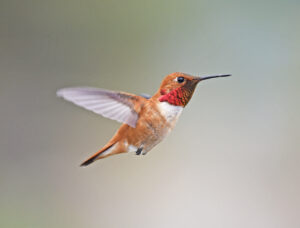
Hummingbird food recipe
Ingredients
- 1 cup of refined granulated white sugar
- 4 cups of water
Directions
- In a saucepan heat your measured water, but it is not necessary to boil
- Stir in measured sugar until dissolved
- Allow to cool to room temperature
Fill the hummingbird feeder with nectar
- Fill feeder with food enough for 2-3 days
Storage
- Store excess sugar water covered in refrigerator for up to 2 weeks
Refilling feeder
- Clean and rinse feeder thoroughly
- Refill with only enough hummingbird food for 2-3 days
How do you steal your neighbor’s hummingbirds? Keep reading! But first, here are some important explanations about the hummingbird food recipe above.
 |
| Rufous Hummingbird. Greg Gillson. |
Do not substitute ingredients in this hummingbird food recipe!
There is so much misinformation on what foods you should or shouldn’t feed hummingbirds. I don’t want to add any of my own opinions. Instead, I will defer to the formula recommended by the Smithsonian’s National Zoo (source).
That expert states to ALWAYS use refined white sugar. That is common table sugar. It further goes on to clarify: NEVER use honey, corn syrup, or raw sugar when feeding hummingbirds. Refining sugar removes any molasses. Molasses contains iron. While iron is good for people, it is very bad for hummingbirds.
Bacteria and fungus thrive in honey mixed with water and left outside, as is the case for hummingbird feeders. These are deadly to hummingbirds. One common fungal infection caused by feeding honey causes the hummingbird’s tongue to swell. The tongue becomes extended and hangs outside the bill. Birds eventually starve. Very sad. Totally preventable.
If you use tap water and a clean mixing bowl, there is no need to boil your water when you make hummingbird nectar. In fact, you don’t even need to heat it at all. Sugar dissolves better in warm water than cold. That’s the only reason to even heat the water. Boiling won’t make clean dishes and ingredients more sanitary or make the food last longer.
Sugar to water ratio for hummingbird food
The Cornell Lab says that the 1:4 or even 1:3 sugar to water ratio matches the sucrose level range typically found in flower nectar that hummingbirds love.
4 to 1 ratio hummingbird food
The ratio of 4 parts water to 1 part sugar is ideal. The Cornell Lab or Ornithology (source) says that this ratio is best during warm weather. The nectar supplies hydration as well as calories.
This 4 to 1 ratio hummingbird food is what you should normally prepare and feed to hummingbirds.
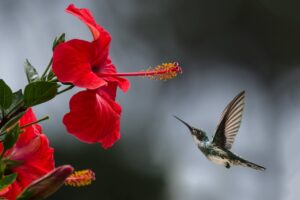
3 to 1 hummingbird food (3 to 1 ratio hummingbird food)
A stronger sugar solution of 3 parts water to 1 part sugar (3 to 1 hummingbird food) can be useful at various times.
When you first set up your hummingbird feeder in spring, this sweeter nectar can more strongly attract hummingbirds. You can get more hummingbirds more quickly to your feeder with this 3 to 1 hummingbird food ratio.
If your hummingbird feeder has run out for several days–for instance if you went on vacation, you may want to set it back up with this stronger 3 to 1 hummingbird food.
A 3 to 1 ratio hummingbird food can provide extra calories during prolonged cold or rainy weather. If you are hosting hummingbirds in the winter, you might try this stronger hummingbird nectar.
5 to 1 hummingbird food
In mid-summer or early fall your hummingbird feeder may be attracting bees. I have read that a weaker sugar solution may not be as enticing to the bees. Thus, a nectar solution with the ratio of 5 parts water to 1 part sugar may still attract hummingbirds and perhaps not bees.
It’s worth a try if bees are a problem!
An added benefit is that your sugar will last longer with this weaker 5 to 1 hummingbird food nectar.
This hummingbird sugar ratio will also provide more hydration during the heat of summer.
What about adding food coloring to homemade hummingbird food?
Whether red food dye is harmful to hummingbirds is open to debate. What is known is that it is totally unnecessary. Most hummingbird feeders have red coloration near the feeding ports. That is sufficient.
Hummingbirds will check out all red objects to see if they might be flowers containing nectar. Once they find your feeder they will return, whether brightly colored or not.
So don’t add food coloring to your hummingbird food.
Why use smaller feeders?
A busy feeder can be emptied by hummingbirds rather quickly. Thus, you may be tempted to buy a larger hummingbird feeder with more ports. Here is why that might not be beneficial for the hummingbirds.
It is a joy to feed hummingbirds. A hummingbird feeder is a safe way to attract and feed these tiny birds. On the other hand, a dirty hummingbird feeder is unsanitary and unsafe for the hummingbirds feeding there.
In warm weather hummingbird feeders should be cleaned every 2-3 days, washed and scrubbed thoroughly with soap and water. In cool weather it may be safe to wash feeders only once per week.
I don’t know about you, but even with the best of intentions I find that it is often inconvenient to clean hummingbird feeders. As a result, they stay hanging for longer than they should. Then the sugar solution may become cloudy with bacteria or filled with disgusting black molds. Yuck! What do I do to protect the birds I am feeding?
I use a smaller feeder and only fill it about halfway (maybe 6 ounces). After 2 days the hummingbirds have emptied the feeder completely. If I don’t notice, or can’t get to it, no harm done. Even after a couple days of an empty feeder it only takes an hour for the hummingbirds to discover that I’ve refilled it.
Please, don’t “top off” your hummingbird feeders when the solution gets low. Take them down and clean them thoroughly before refilling. Every time. Please.
For this reason, rather than purchasing a single larger feeder, place out several smaller feeders that will be emptied completely within 3 days. Then clean and refill each feeder as needed. Don’t let hummingbird feeders sit out with moldy food!
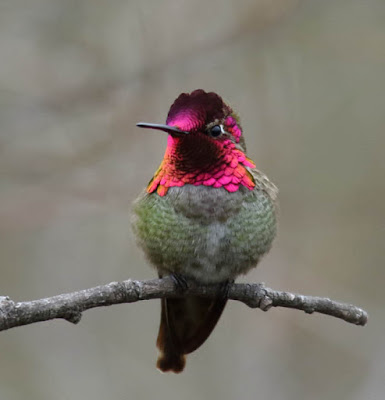 |
| Anna’s Hummingbird. Greg Gillson. |
Steal your neighbor’s hummingbirds!
It is really easy to get hummingbirds to come to a new feeder. That’s one of the reasons feeding these little jewels is so popular. One of the main reasons for this ease of attraction to new feeders is that hummingbirds aggressively protect their food sources from other hummingbirds. These feeding territories are quite small.
Your neighbor’s feeder no doubt has one dominant individual that attacks all others entering its domain. It probably also has several other more submissive birds that try to sneak in and get a drink when the boss is occupied chasing someone else away. All this chasing and sneaking and buzzing and twittering is one thing that makes watching hummingbirds so entertaining!
If you set up a new feeder at your home following the recipe above, the next-most-aggressive hummingbird in the pecking order will probably set up a territory at your feeder. What do you do to keep one bird from driving all the others away? Set up more feeders!
You might try putting two or more feeders near each other. The thought is that these feeders will attract more birds. The dominant bird will eventually tire out of chasing all the other birds and finally let them feed in (relative) peace. One of my neighbors has 3 feeders near each other and always has at least a half dozen hummingbirds at a time buzzing around them.
Alternatively, set up another feeder out-of-sight of the first feeder. That way submissive birds can feed in peace at the second “hidden” feeder. Last summer I had a male Anna’s Hummingbird that set up a territory that included the hummingbird feeder in my backyard. This bird sat up in a bottlebrush tree surveying his kingdom. He would not let any other hummingbird near the feeder. So I set up another feeder around the corner, hidden from his view. This allowed several other hummingbirds to feed regularly.
Remember that the Cornell Lab says you can adjust the hummingbird food recipe from 1:4 to a 1:3 sugar to water ratio during cold weather? You can also make a more concentrated sugar mixture (3 parts water to 1 part sugar) when you first set up a feeder. The extra sweet nectar will pull birds quickly away from your neighbor’s feeder! Once established, go back to the 1:4 ratio.
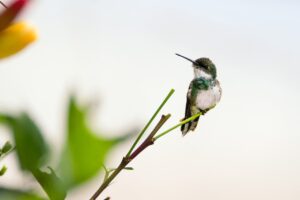
Do hummingbirds eat any other foods besides nectar?
The sugar recipe we outline in our nectar feeder for hummingbirds provides only 2 things: hydration (water) and calories (sucrose). Because of their high metabolism rate, hummingbirds need both of these things daily, in fact, they must eat every 10-15 minutes! (source) But they also need protein.
Hummingbirds meet their protein needs by eating small insects and spiders. You may see hummingbirds inspecting plants and flowers in your yards looking for a protein snack.
Want to try feeding insects to hummingbirds? A bowl of over-ripe fruit or banana peels will attract fruit flies. The hummingbirds will love it!
So there you have it, two recipes for hummingbird food: a nectar recipe and a fruit fly recipe! Both are simple and inexpensive and good for the birds. Enjoy!
Wrapping Up
Hummingbirds’ love for sugar water stems from a combination of their unique physiology and dietary needs:
High Energy Demands:
Hummingbirds are the smallest avian residents of many regions and boast the highest metabolic rate of any warm-blooded animal. They can flap their wings up to 200 times per second, requiring an immense amount of energy to sustain their hovering flight and acrobatic maneuvers.
This requires a diet rich in readily available sugar, the most immediate source of energy for most animals. While they do glean some energy from insects and pollen, flowers and sugar water offer a concentrated and easily digestible source of fuel to meet their demanding needs.
Flower Mimicry:
Hummingbirds have evolved long, slender beaks perfectly adapted for reaching the nectar within tubular flowers. Their tongues, with brush-like tips, efficiently collect and extract the sugary liquid.
Sugar water mimics the sweet nectar found in flowers, appealing to the natural foraging instincts of hummingbirds. The readily available sweetness attracts them to readily consume, replenishing their energy reserves quickly.
Frequently Asked Questions
Why do you have to boil sugar water for hummingbirds?
Boiling sugar water for hummingbird feeders isn’t really necessary. Here are some reasons why:
If you use clean water and replace the nectar frequently (every few days, especially in hot weather), boiling isn’t absolutely necessary. Hummingbirds have strong immune systems and can usually handle small amounts of bacteria.
Boiling adds an extra step to preparing the nectar, which might not be necessary in every situation.
Boiling helps, but doesn’t completely eliminate all bacteria. Hummingbirds will still encounter bacteria from other sources and their natural environment.
What is the healthiest nectar for hummingbirds?
When it comes to hummingbird nectar, the healthiest option for these feathered friends strikes a balance between readily available energy and essential nutrients. While sugar water plays a vital role in their diet, a completely reliant source isn’t ideal.
If you want to put out sugar water for the hummers, also consider:
Providing natural sources of nectar through native flowering plants in your garden. Flowers offer not only sugar but also essential nutrients, pollen, and protein that sugar water lacks
Hummingbirds also eat small insects, which provide vital protein and fats. Planting insect-attracting flowers and allowing some “messy” areas in your garden can encourage a natural food source.
How long can sugar water sit out for hummingbirds?
The question of how long sugar water can sit out for hummingbirds depends on several factors, including:
In hot weather, bacteria grow more quickly in sugar water. Ideally, change the nectar every 1-2 days in these conditions. However, in cooler weather, bacteria growth slows down. Sugar water can potentially last for 2-3 days, but still keep an eye on it for signs of spoilage.
If the hummingbirds are quickly emptying the feeder, the sugar water is less likely to spoil. You can still aim for changing it every few days to be safe. If the nectar sits in the feeder for longer, it’s more susceptible to spoilage. Monitor it closely and replace it sooner if it changes in color, develops a film, or starts to smell sour.
It is really important to look out for signs of spoilage:
- If the nectar becomes cloudy or opaque, it’s likely due to bacterial growth and should be replaced.
- Any visible mold on the feeder or in the nectar means it’s time for a fresh batch.
- If the nectar smells sour or fermented, it’s definitely spoiled and needs to be replaced immediately.
Related Article:



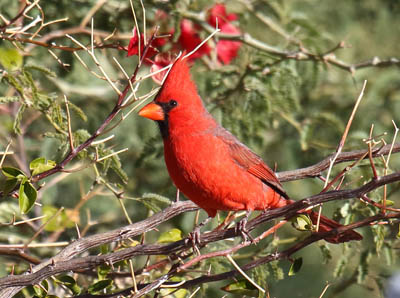
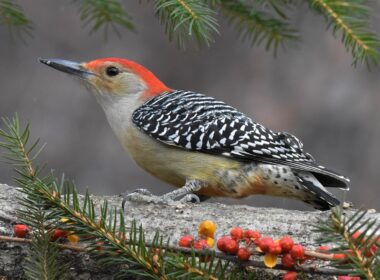
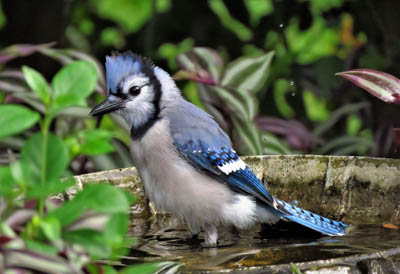
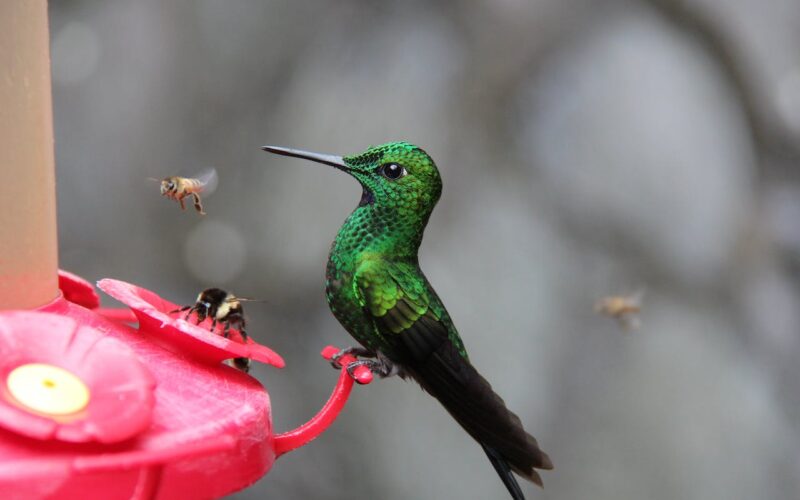
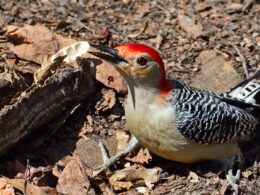
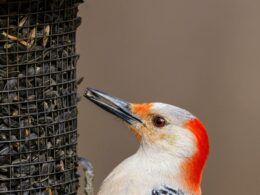

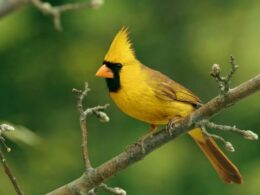
Great article! my hummingbird feeder is now located near a bird house. I think she is driving all of the hummingbirds away. How far apart should they be located?
Thanks for commenting, Monica!
If a bird is nesting in the bird house it may be territorial against birds in the yard. Fortunately, nesting season only lasts about a month (2 weeks eggs, 2 weeks nestlings).
You might try moving the hummingbird feeder 10 feet away and see what happens. Or, you might just wait another week or two….
Thank you for all the great information. I will definitely be making a few changes feeding our year round hummingbirds.
Thanks for commenting, Karen. With year-round hummingbirds it is easier to see the effects of trying new things.
Loved your article! Thank you for such thorough information (with sources- just amazing!).
Thank you for your kind words.
What about using confectionery sugar?
I had to look this up. Powdered sugar or confectioner's sugar is ground up white sugar WITH ADDED CORN STARCH.
Don't use this to make nectar for hummingbirds.
How can I keep the bees away from my humming bird feeders. My neighbor across the street has been hives and my humming birds spend more time, sometimes, chasing the bees away.
I wrote an article on how to keep bees away from hummingbird feeders.
https://whatbirdsareinmybackyard.com/2020/06/how-do-i-get-rid-of-bees-at-my-hummingbird-feeder.html
It’s that time of year again in Indiana! I always check Google for an accurate at hone recipe for Hummingbird nectar. Thank you for yours! I’m on it! 😎😆
The hummingbirds are drinking my 10 ounce feeder dry in about a day and a half. I only see a couple of Rufous and a couple of Anna's. But I bet if I took some time to sit and watch I'd be surprised how many birds might be present.